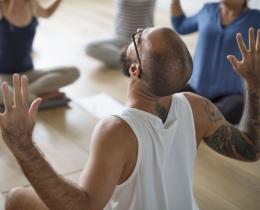Omega: We have an epidemic of chronic pain, especially low back pain. When you’re in pain the last thing you want to do is move, so how do you convince people that movement is part of the solution?
Miranda: People tend to think it’s all or nothing—that they need to do a big workout or nothing at all. I have people who are in pain, find the place they are not in pain. I have yet to meet anyone who doesn’t have a place where they can move where they’re not in pain. It might be a very little movement, but there is movement. That’s where they can start. Maybe they’re just wiggling something and hardly moving at all. That’s okay. Just wiggle and then move a little more.
Pain is a message. You try to turn it off through very small movements where you don’t trigger the pain. The body will learn from this within nanoseconds. Once it sees that this isn’t hurting you, it’ll let you go a little further. You can slowly move a person out of immediate pain when they move, to being able to move pain-free until they find their pain point, where the genuine damage is. You should never work in pain—work in the zone where you’re not in pain and then the body will understand what’s going on.
The actual pain can’t heal if you’re always in protection mode. So if you can get out of protection mode by moving less, and moving in places where there is no pain, the results can be quite amazing.
Omega: So “no pain, no gain” is not a very good approach?
Miranda: It’s completely for the birds! It’s a criminal philosophy, but we were ignorant when the fitness industry started and it sounded good at the time. We were all young and we were excited to be in pain.
Omega: What do you think about the surge in popularity of extreme races, like mud runs and obstacle courses, especially for people in their 40s, 50s, and 60s?
Miranda: Most people who try to do these things get injured because their body can’t handle it. If they work only to shorten their muscles, they’ll unbalance their body and they’re going to be in pain. There’s no way around it. But most of them don’t want to hear my message or my story. That’s okay. Some people do our program to help them do things like this better—I have a lot of CrossFit people come—but I don’t lecture them on it. It’s like religion—you don’t interfere with somebody else’s fitness journey. If they come to me, I’ll teach them, but generally people don’t want to be told what they’re doing is bad for them.
Omega: How did your experience of pain and injury contribute to your evolution from ballet dancer to Essentrics creator?
Miranda: I’ve been in pain so many times. I’ve had breast cancer, I’ve had chronic back pain, I’ve had a broken foot and broken wrist and all kinds of surgeries. It all helped me understand what I’m talking about from a first-hand place. I’m almost 70 and for five years now I’ve been pain-free, healthy, and vibrant. I feel like I’m 30. A few months ago we were filming in Mexico and I literally ran up and down a pyramid with 126 steps with no effort. I am full of energy—I’m writing two books, I finished two TV shows, and I’m teaching retreats. I think this is what everybody my age should feel.
When I was 30 I felt like a 60-year-old. I was in pain all the time. I was at the doctor’s office all the time and crippled from back pain. I’ve not only healed from all that, I’ve completely reversed it all. So not only have I done all the work on the science of it, I am also speaking from my personal experience.




